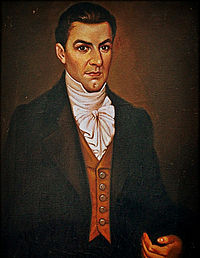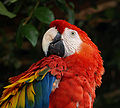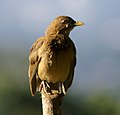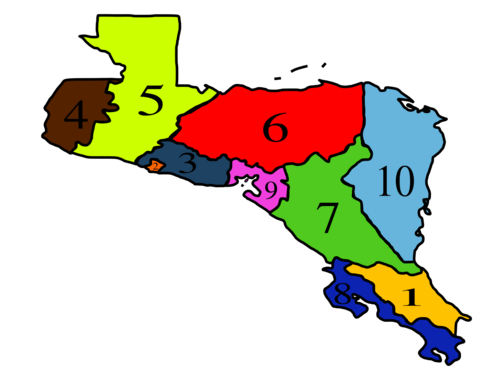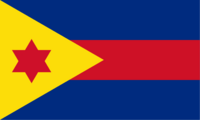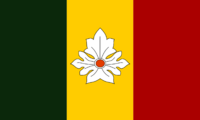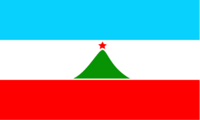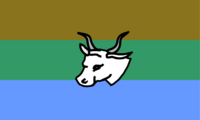Federation of Central America
Federation of Central America Federación de Centroamérica | |
|---|---|
|
Motto: "Dios, Unión, Libertad" "God, Union, Liberty" | |
|
Anthem: La Granadera "The Song of the Grenadier" | |
 | |
| Capital | Sonsonate |
| Largest city | Guatemala City |
| Official languages | Spanish |
| Recognised regional languages | English · Mayan · Garifuna · Others |
| Demonym(s) | Central American |
| Government | Federal presidential constitutional republic |
| Maria Magaña (AD) | |
| Eva Campbell (PLP) | |
| Hilario Barrios (AD) | |
| Legislature | Constitutional Assembly |
| House of Initiatives | |
| House of Delegates | |
| Establishment | |
• Independence from Spanish Empire | Sept. 18, 1821 |
| July 1, 1823 | |
• First dissolution | Feb. 18, 1841 |
| Sept. 15, 1896 | |
• Second dissolution | Nov. 25, 1898 |
| 1979–1985 | |
| Oct. 5, 1985 | |
• Establishment of federation | Dec. 30, 1985 |
• Constitution of federation | Jan. 16, 1986 |
| Area | |
• Total | 425,397 km2 (164,247 sq mi) |
| Population | |
• 2020 estimate | 42,610,347 |
• Density | 100/km2 (259.0/sq mi) |
| GDP (PPP) | 2020 estimate |
• Total | KS$391.923 billion |
| HDI (2019) |
0.688 medium |
| Currency | Central American real (CA) |
| Time zone | Central American Standard Time (UTC−06:00 to UTC−05:00) |
| ISO 3166 code | CTAM |
| Internet TLD | .fca |
Central America[note 1], officially the Federation of Central America (Spanish: Federación de Centroamérica; FCA), is a country located in the southernmost part of North America.[note 2] It borders Mexico to the north, Pacific Ocean to the west, the United People's Committees to the south, Belize to the northeast, and the Caribbean Sea to the east. The capital is Sonsonate and the largest city is Guatemala City. The total population is estimated at 42.61 million as of 2021. Most of the country's territory is covered in tropical and subtropical coniferous forests and it is classified as a biodiversity hotspot due to the wide variety of plant and animal species native to Central America. It is also located along several geologic active faults, as well as the Central America Volcanic Arc.
The region of modern Central America was inhabited by the indigenous peoples of Mesoamerica and Isthmo-Colombian regions since the end of the last ice age. Spain began to colonize the Central America during and after the expedition of Christopher Columbus. From 1609 to 1821, the majority of Central American territories were governed by the Viceroyalty of New Spain from Mexico City as the Captaincy General of Guatemala. After its independence from Spain, the former Captaincy General became a part of the short-lived First Mexican Empire. On 1 July 1823, it declared independence from Mexico to form the Federal Republic of Central America. That state was dissolved into the independent republics of Guatemala, El Salvador, Nicaragua, Honduras, and Costa Rica. Five decades after the dissolution of the federation, the Greater Republic of Central America was established and it was only composed of El Salvador, Honduras, and Nicaragua but the second unification was lasted only three years in the late 19th century. Political instability continued to effect the Central American republics throughout the 20th century, culminating in the Central American crisis during the Cold War between the United Commonwealth and Sierra, which saw Sierran-backed military governments fight against left-wing guerilla groups assisted by the U.C. The Treaty of Sonsonate established the Federation in 1985 as a unification of the five republics within a multi-party democracy to restore order to the region, allowing a coalition government involving both previous factions, and was recognized as a neutral state by both Sierra and the Commonwealth. In the late 1990s, the country applied for membership in the Conference of American States, receiving it in 2002.
Central America is a federal republic with a presidential system, making the president is both head of state and head of government. The national legislature is the bicameral Constitutional Assembly, which divided into two chambers: House of Initiatives (upper house) and House of Delegates (lower house). The current constitution, promulgated in 1986, defines Central America as having a division of powers between the federal and state governments, as well as between the executive, legislative, and judicial branches of the federal government. The borders of its states were changed from the previous five sovereign republics to promote unity, giving the country ten states.
Central America is considered to be a upper middle-income economy by the World Bank with prominent agricultural and manufacturing sectors, but continues to struggle with addressing gang violence, economic inequality, and human rights abuses. Since joining the CAS and becoming part of the American Single Market, the country has seen rapid economic growth, including in wages, though the development has been highly uneven. The Nicaragua Canal is a major route for maritime shipping between the Pacific and Atlantic Oceans and provides the government with a significant portion of its revenue, though since the end of the Cold War has led to greater accessibility of the Panama Canal in the United People's Committees, its importance and share of cross-ocean shipping has declined. Central America is a member of international organizations such as the Conference of American States, the League of Nations, and the WTO.
Etymology
Federation of Central America is the official name that has been used for the country since the current constitution in 1986, with the common name being Central America. The acronym FCA is also frequently used to refer to the country, and it is sometimes called Centroamerica, mirroring the Spanish form of the name. The country is distinguished by the League of Nations in its geographic classification from the region of Central America by defining the latter as every territory to the south of the Sierran and Brazorian borders, and to the north of the Panama Canal. This means that Mexico, Belize, part of Sierra (Bajaría), and part of the United People's Committees (Panama) are also considered part of the larger geographic region of Central America, along with the FCA. The five republics that combined to form the FCA have always had a strong Central American identity, while Mexico has its own separate national identity, Belize identifies more with Caribbean culture, and Panama sees itself as culturally closer to its South American neighbors. Sometimes the term Middle America is used for the region instead of Central America, to avoid confusing the entire region for the country, though this is not used frequently – the current convention in English-speaking countries is to still call both the geographic area and the country "Central America."
Among Central American citizens, the Spanish term América Central is used to refer to the larger region while Centroamerica is used for their nation. This convention, which is frequently used today in other Spanish-speaking countries, emerged in the early 19th century, when the Federal Republic of Central America briefly existed as a unified country before dissolving.
History
Early history
During Pre-Columbian era, the country was inhabited by the indigenous people of Mesoamerica especially Mayans and Aztecs. The Mayans could built numerous cities throughout the region while the Aztecs had created a vast empire. The pre-Columbian cultures of some parts of Central America, Nicaragua, Costa Rica and Panama were predominantly speakers of the Chibchan languages at the time of European contact.
Spanish colonization
Federal Republic of Central America
In 1821 a congress of Central American Criollos in Guatemala City composed the Act of Independence of Central America to declare the independence from Spain, effective on September 15 of that year. The process was bloodless with no resistance from the Spanish authorities as the royal governors were retained in office as executive powers pending a full transition to local rule. In 1822, the independence became short-lived and most of the parts of the country annexed by the Mexican Empire. Many localities refused to accept the newly formed federal powers in Guatemala and the major cities of the country at that time were in open revolt. On January 25, 1822, the Junta consultiva in Guatemala City voted for annexation. A few weeks later General Vicente Filísola, the envoy of Emperor Agustín de Iturbide of the First Mexican Empire, arrived in Guatemala as the new ruler. The annexation was controversial, with some seeing the Mexican constitution with its abolition of slavery and establishment of free trade as an improvement over the status quo. Central American liberals in San Salvador objected to this and refused to accept Filísola's authority. Costa Rica decided not to join in Mexican Empire due to the Ochomongo War in April 5, 1823, where imperialists lost against Republicans in the first civil war of Costa Rica. In July 1, 1823, the Congress of the country declared independence from Spain, Mexico, or any other foreign nation, and established a republican system of government.
In 1825, José Cecilio del Valle won against Manuel José Arce in the presidential elections but the Congress provoked the votes and they did the second round so that Arce won for presidency. Arce soon lost his support of the Liberals in the Congress. He got some support from the Conservatives but there are difficulties in Guatemala. He removed Juan Barrundia as a governor of Guatemala and replaced him. The Salvadoran state government are angry and rebelled that resulted on a civil war that lasted from 1826 to 1829. On 1829, Vice President Mariano Beltranena temporarily became president but when Arce wanted to resume his presidency, Beltrana refused and remained in office until April 1829 when the Liberals entered Guatemala City and overthrow his administration.
The federation experienced conflicts between 1838 and 1840 that resulted into civil war. It began when Nicaragua separated from the federation on November 5, 1838 followed by Honduras and Costa Rica. As a result, the Congress declared that the provinces were free to declare independence and form their own republics. The federation was officially ended in 1841 when El Salvador proclaimed as an independent republic.
Reunification attempts
The first reunification attempt was in 1842 when former President Francisco Morazán struggled for control over Costa Rica. After taking control the capital, Morazán announced that he would re-create the Federal Republic as Confederation of Central America and planned to include the four other former states of the federation but it was failed because Morazán was killed by the firing squad on September 15, 1852. The second reunification attempt was made in October 1852 when the Central American countries except Guatemala and Costa Rica formed the Federation of Central America (the today's official name of the country) but it lasted less than a month.
Greater Republic of Central America
The Treaty of Amapala was signed on June 20, 1895 and it was agreed by El Salvador, Honduras, and Nicaragua. After the treaty signed, the federation was officially established on September 15, 1896.
20th century
Post-Greater Republic period
Great Wars
Central American crisis, Treaty of Sonsonate and third unification
The Central American crisis was happened from 1980 to 1985 because of opposing leftism and nationalization efforts. There would be some peace talks to help for solving the conflict and the Treaty of Sonsonate was signed in October 5, 1985 and the war was ended on the same day. The establishment of the federation was happened in December 30, 1985. The constitution was ratified on January 16, 1986 and Alonzo de Guzmán became the intern president of Central America at that time but he didn't run for presidency in 1987 elections. The first round of the first election was happened on February 2, 1987 and the candidates are Leonel Aguilar of the Nationalist Party, Geovanni Valverde of the Democratic Alliance, Francisco Ponce of the New Nation Party, Martina Zamora of the People's Rights Party. On the first round, Aguilar and Valverde got the highest votes and they are the candidates for the second round. The second round was happened in April 2, 1987 and Leonel Aguilar won for presidency against Geovanni Valverde. Under the Nationalist Party, Central America would take a more anti-Landonist stance in regards to foreign policy, aligning with Sierra and Anglo-American alliance. Periodic anti-Landonist raids, against both foreign and domestic proponents of the ideology.
21st century
Geography

The Federation of Central America is a part of North America that is an isthmus extending from the southern border of Mexico to the northernmost tip of South America. It is bordered by Mexico to the north, Belize to the northeast, the Caribbean Sea of the Atlantic Ocean to the east, the United People's Committees to the south, and the Pacific Ocean to the west. The country represents only part of the geographic region of Central America, which also includes the independent country of Belize and the Andean territory of Panama. The Federation of Central America–Mexico border is considered to be the northern and northwestern boundary of the region of Central America with the rest of the North America. The country has a total area of approximately 164,247 square miles (425,397 km²). There are several islands and atolls that are located within Central American territory or its exclusive economic zone off the southern and northern coasts, including the Bay Islands, Meanguera Island, Rosario Bank, and Misteriosa Bank. Cocos Island, located in the Pacific Ocean about 340 miles (550 km) southwest of the Central American mainland (the state of Costa Rica), is the southernmost point of geopolitical North America.
The terrain of Central America is characterized by three regions: the Pacific coast lowlands; the highlands, running through the central and western parts of the country; and the Caribbean coast. The lowlands on both coasts tend to be hot and humid (tropical climate) while the highlands are drier and colder (temperate climate). The location of the country between two oceans makes it a target for hurricanes, with major ones hitting Central America in 1998 and 2005, each causing thousands of deaths.
Central America is in one of the most geologically dynamic regions on earth, with the Motagua Fault, a transform fault between the Caribbean Plate and the North American Plate, passing through the northern part of the country near the Mexican and Belizean borders; and the Central American Volcanic Arc, on a subduction zone between the Caribbean Plate and the Cocos Plate in the Pacific Ocean, passing along the western coast of the country. This makes the western and northern edges of Central America mountainous and volcanic, with the region stretching for nearly 700 miles (1,100 km) and containing many sporadically active volcanoes. Earthquakes and volcanic eruptions occur every several years, and historically the capitals of Guatemala and El Salvador had to be moved several times due to damage caused by earthquakes, while highland villages are occasionally damaged by volcanic eruptions.
Despite all of the geologic activity, the mountain ranges in the country are suitable for raising of livestock and production of coffee, tobacco, beans and other crops. Fertile soils from weathered volcanic lava have made it possible to sustain dense populations in the agriculturally productive highland areas. Of all the mountain ranges in the country, the longest are the Sierra Madre de Chiapas, Cordillera Isabelia and Cordillera de Talamanca. While the highest peak in Central America is Volcán Tajumulco in the state of Guatemala. The other highest peak in the country are listed below:
| Images | State | Name | Elevation (meters) | Range |
|---|---|---|---|---|
| Volcán Tajumulco | 4220 | Sierra Madre de Chiapas | ||
| Cerro Chirripó | 3820 | Cordillera de Talamanca | ||
| Cerro Las Minas | 2780 | Cordillera de Celaque | ||
| Cerro El Pital | 2730 | Sierra Madre de Chiapas | ||
| Mogotón | 2107 | Cordillera Isabelia |
Flora and fauna
Montecristo National Park, El Salvador
Maderas forest, Nicaragua
Monteverde Cloud Forest Reserve, Costa Rica.
Petén–Veracruz moist forests, Guatemala
Cocos Island, Costa Rica
Central America is part of the Mesoamerican biodiversity hotspot, boasting 7% of the world's biodiversity. The Pacific Flyway is a major north–south flyway for migratory birds in the Americas, extending from Alaska to Tierra del Fuego, Patagonia. Due to the funnel-like shape of its land mass, migratory birds can be seen in very high concentrations in Central America, especially in the spring and autumn. As a bridge between North America and South America, Central America has many species from the Nearctic and the Neotropical realms. However the southern states (Costa Rica) of the region have more biodiversity than the northern states (Guatemala and Belize), meanwhile the central states (Honduras, Nicaragua and El Salvador) have the least biodiversity.
In recent years Central America has seen a significant deforestation problem, with 1.2% of its forests disappearing per year. Partly because of this, over 300 species of the region's flora and fauna are threatened, 107 of which are classified as critically endangered. Since 2006 there has been an effort to preserve forests and species through protected national parks, reserves, and ecoregions. Ecoregions are not only established to protect the forests themselves but also because they are habitats for an incomparably rich and often endemic fauna. Half of the bird species and many amphibians are endemic to this part of the world. The golden toad that once inhabited a small region in the Monteverde Reserve, which is part of the Talamancan montane forests, has not been seen alive since 1989 and is listed as extinct by IUCN. Jaguars, cougars, spider monkeys, as well as tapirs and anteaters live in the woods of Central America. The Central American red brocket is a brocket deer found in Central America's tropical forest.
The Central American pine-oak forests ecoregion, in the tropical and subtropical coniferous forests biome, is found in Central America and southern Mexico. The Central American pine-oak forests occupy an area of 111,400 square kilometers (43,000 sq mi), extending along the mountainous spine of Central America, extending from the Sierra Madre de Chiapas in Mexico's Chiapas state through the highlands of Guatemala, El Salvador, and Honduras to central Nicaragua. The pine-oak forests lie between 600–1,800 meters (2,000–5,900 ft) elevation, and are surrounded at lower elevations by tropical moist forests and tropical dry forests. Higher elevations above 1,800 meters (5,900 ft) are usually covered with Central American montane forests. The Central American pine-oak forests are composed of many species characteristic of temperate North America including oak, pine, fir, and cypress.
The Central American montane forests are an ecoregion of the tropical and subtropical moist broadleaf forests biome. These forests are of the moist deciduous and the semi-evergreen seasonal subtype of tropical and subtropical moist broadleaf forests and receive high overall rainfall with a warm summer wet season and a cooler winter dry season. Central American montane forests consist of forest patches located at altitudes ranging from 1,800–4,000 meters (5,900–13,100 ft), on the summits and slopes of the highest mountains in Central America ranging from Southern Mexico, through Guatemala, El Salvador, and Honduras, to northern Nicaragua. The entire ecoregion covers an area of 13,200 square kilometers (5,100 sq mi) and has a temperate climate with relatively high precipitation levels.
Laurel forest is the most common type of Central American temperate evergreen cloud forest, found in almost all Central American countries, normally more than 1,000 meters (3,300 ft) above sea level. Tree species include evergreen oaks, members of the laurel family, species of Weinmannia and Magnolia, and Drimys granadensis. The cloud forest of Sierra de las Minas, Guatemala, is the largest in Central America. In some areas of southeastern Honduras there are cloud forests, the largest located near the border with Nicaragua. In Nicaragua, cloud forests are situated near the border with Honduras, but many were cleared to grow coffee. There are still some temperate evergreen hills in the north. The only cloud forest in the Pacific coastal zone of Central America is on the Mombacho volcano in Nicaragua. In Costa Rica, there are laurel forests in the Cordillera de Tilarán and Volcán Arenal, called Monteverde, also in the Cordillera de Talamanca.
National trees
Enterolobium cyclocarpum Costa Rica
Tabebuia rosea El Salvador
Malvaviscus palmanus Punta
Pinus oocarpa Honduras
Calycophyllum candidissimum Nicaragua
Swietenia macrophylla Los Altos and Distrito Capital
Ceiba Guatemala
Swietenia humilis Victoria
Caribbean pine Zelaya
National flowers
Lycaste skinneri, Guatemala
Izote flower, El Salvador and Distrito Capital
Rhyncholaelia digbyana, Honduras
Plumeria, Nicaragua
Guarianthe skinneri, Costa Rica
Lepanthes guatemalensis, Los Altos
Stanhopea ecornuta, Victoria and Zelaya
National birds
Resplendent quetzal, Guatemala
Turquoise-browed motmot, El Salvador and Nicaragua
Scarlet macaw, Honduras
Clay-colored thrush, Costa Rica
Harpy eagle, Punta and Zelaya
White-bellied chachalaca, Distrito Capital
Buffy-crowned wood partridge, Los Altos
Hepatic tanager, Victoria
Climate
Trade winds have a significant effect upon the climate of the country. The temperatures in the country are highest before the summer wet season while the lowest is experienced during the winter dry season. The highest temperature can be experienced every April because of the higher sunlight. The climate is largely tropical with only two seasons: wet and dry seasons. Wet season occurs during the summer especially between May and November. Dry season occurs from January through March.
Government and politics
Central America is a federal presidential constitutional representative democratic republic, which serves as the foundation of the executive, legislative, and judicial branches. Like most presidential systems, the president of Central America is the head of state and also the head of government, and serves as the commander-in-chief of the Armed Forces of Central America. The vice president presides over the legislature, serves as the head of the upper house of parliament, and takes presidential powers in the event that the president becomes incapacitated. The president and vice president are elected in a national popular vote for one five-year term that is not renewable. The powers of the Central American president are more limited compared to many other presidential systems, such as not being able to veto congressional budgets.
The legislature of the country, the Constitutional Assembly, is bicameral and it is divided into two houses: House of Initiatives (upper house) and House of Delegates (lower house). The House of Initiatives has fifty members, five for each federal state and the capital district. The House of Delegates has 234 members, with one member for each electoral district. Members of the House of Initiatives are state-wide elected offices, while members of the House of Delegates are elected in smaller electoral districts, with multiple districts in each state.
The judiciary consists of the Supreme Court of Central America, whose members are elected by the Constitutional Assembly after being nominated by the president, and there is also a Supreme Electoral Tribunal, which is tasked with overseeing elections and ensuring the transition of power based on the results of an election. The Supreme Court also resolves disputes between the presidency and the Assembly.
There is also an Audit Chamber and a Human Rights Commission, which are tasked with overseeing the actions of other branches of government and their agencies, as well as bringing cases to the Disciplinary Court in the event of legal violations by agencies. Cases resulting from government violations of the law or overreach are in the jurisdiction of the Disciplinary Court, though in some cases the Supreme Court is also used as the court of last resort for settling such cases. This system was established by the 1986 constitution of the Federation of Central America to create additional checks and balances on other government branches.
Political culture
The political system of the Federation of Central America was developed in the aftermath of decades-long civil wars and insurgencies, which themselves were preceded by a long pattern of political instability going back to the 19th century in the five independent republics that founded the modern federation. The constitutional and federal structure with many checks and balances is intended to prevent instability and maintain strong civilian control over the armed forces, the national police, and intelligence agencies, with certain powers being clearly delegated by the constitution to the federal government and others to the state and local governments.
Efforts have been made over the decades to strengthen the independence of institutions, to prevent the creation of personal dictatorships that dominated the history of Central America before the creation of the federation. Such elements include a court system and auditory agencies that can bring cases against members of the executive and legislative branches if they overstep their constitutional responsibilities in a serious way, and the power of the legislature to pass the annual government budget without being vetoed by the president. Legal provisions have been made for the government to provide accessible and efficient public services, especially in healthcare and education. Despite this, there have been challenges in the implementation of this system, such as avoiding the concentration of power in small groups of political and economic elites, or the slow functioning of the government in certain instances due to lengthy court procedures. Nonetheless, the Economist Intelligence Unit's Democracy Index has classified Central America to be a "full democracy" every year since 2015, with political scientists considering the Central American political system to have been successful in establishing a stable democratic institutions.
Each of the major political parties have all pledged in their electoral platforms to work to maintain this system and avoid a return to the instability that characterized Central America before the Federation was established.
Administrative divisions
Central America is organized into nine states and one district on the first level of subdivisions, and these are further subdivided into 78 departments. Each state and the capital district are led by an elected governor, and also have an elected state legislature.
| Federal States of Central America | ||||||
|---|---|---|---|---|---|---|
| No. | Flag | States | Capital | Established | Area (km2) |
Population (2020) |
| 1 | Costa Rica | San José | 1986 | 29,693 | 4,218,500 | |
| 2 | Distrito Capital | Sonsonate | 1986 | 1,226 | 71,980 | |
| 3 | El Salvador | San Salvador | 1986 | 19,815 | 6,416,120 | |
| 4 | Los Altos | Quatzaltenango | 1990 | 25,556 | 5,672,931 | |
| 5 | Guatemala | Guatemala City | 1986 | 83,333 | 9,228,355 | |
| 6 | Honduras | Tegucigalpa | 1986 | 90,591 | 8,535,080 | |
| 7 | Nicaragua | Managua | 1986 | 70,009 | 5,161,273 | |
| 8 | Punta | Nicoya | 1994 | 21,407 | 892,700 | |
| 9 | Victoria | Choluteca | 2002 | 6,025 | 1,382,606 | |
| 10 | Zelaya | Bluefields | 1996 | 77,363 | 1,032,830 | |
Political parties
Central America has a multi-party system and citizens aged 16 and above have the right to vote. The country has five major political parties that dominate national politics. These parties are Nationalist Party, Democratic Alliance, Social Democratic Party, Unity Party, and Liberal Progressive Party, and a number of smaller parties, some of which are also in the national legislature.
| Name | Founded | Ideology | Lower house seats | Upper house seats | Political position | AP
affliliation | |
|---|---|---|---|---|---|---|---|
| Democratic Alliance | 1987 | Social liberalism
Social democracy |
Center-left | Liberal Democrats of America | |||
| Nationalist Party | 1987 | Social conservatism
Christian democracy |
Center-right | ||||
| Social Democratic Party | 1991 | Democratic socialism
Social democracy |
Center-left to left-wing | Social Democrats of America | |||
| Unity Party | 2004 | Social conservatism
Christian democracy |
Center-right to right-wing | American Conservative Coalition | |||
Foreign relations
Central America is a member of the League of Nations and the Conference of American States.
From the late 1980s until the mid-1990s the country had a border dispute with Belize, though this was resolved by a joint commission that demarcated their border in 1995.
Military
Economy
The economy of Central America is dominated by both agricultural and industrial sectors. It is known for bigger production in rice, coffee, sugar, and bananas in the world. The country is one of the smallest cheap labor in the American continent because the government supported the agricultural and industrial sectors in the country and they give financial assistance to the people every December. The country is also known as the biggest maquila production in the world with many maquila factories are from the country that mostly worked by women.
Infrastructure
Rail
The Federation of Central America inherited 2,656 kilometers of railroads when it was established in 1985, the majority of them being in a state of disrepair after the civil wars since the late 1970s. The Ferrocarril Nacional de Centroamérica (FNC) lacked the resources and funding for a major upgrade of the rail network, and in December 1996 Ferromex (Mexican Railways) was granted the right to develop the country's railway jointly with FNC. The China Harbour Engineering Company joined in the project in 2002, aiming to create a transoceanic rail line between the Pacific and Caribbean coasts. By 2007 much of the country's railways were upgraded, with a north-south main line running through the center of the country between Guatemala City, Comayagua, Managua, and San José. The line was further extended from Guatemala City to the Mexican border and from San José to the Andean border. Additionally there are several routes that branch off from the north-south line and extend to cities along the two coasts. Currently there is regular passenger service along these lines, but freight traffic is given the priority. The rail network is jointly run by the FNC and Ferromex.
Tourism
During the administration of former president Geovanni Valverde, he created for tourism to create jobs for the people and combat poverty throughout the country. The growth of tourism has positively affected the different sectors such as agriculture, commercial, finance, and construction. Among all the federal states in Central America, Costa Rica is the most visited state in the country and it is considered as the "Tourism Capital of Central America". The tourism sector became the largest source of foreign revenue in 1995. Since 2000, the tourism has earned more foreign exchange than exporting agricultural products. The tourism boom began in 1988, with the number of visitors up from 2.1 million in the same year, through 9 million in 2000. In 2013, tourism contributed with 14% of the country's GDP and it was responsible for 10.2% of indirect and direct employment. The result for Central America's tourism-driven economy have been significant, with the nation welcoming millions of tourists every year.
Central America has many sites of natural beauty that attract about nine million tourists annually, as of 2016.
Demographics
- State capitals of Central America
- NuevaPlazaMorazán2018.jpg
The population of Central America was estimated at 42,610,347 in 2020.
Ethnic groups
Language
Central American Spanish is divided into five dialects: Costa Rican, Guatemalan, Honduran, Nicaraguan, and Salvadoran. Each dialects have their unique characteristics and all of the dialects have different influences in terms of the place of origin. Vocabulary, accents, and colloquial languages can be vary in all federal states in the country. Central American Sign Language have emerged since 1990's among deaf children as a result of free special education program of the government.
English is the second language of Nicaragua and Zelaya and these states have largest percentage with 6.2% of its combined English-speaking population of the two states. However, the percentage of these two states are smaller than neighboring country, Belize. Mayan languages are also spoken in different parts of the country, with Los Altos have the largest percentage with 45.3% of the state's pooulation and Guatemala is the second largest with 17.6%.
Religion
The predominant religion in Central America is Christianity (95.6%). Beginning with the Spanish colonization of Central America in the 16th century, Roman Catholic became the most popular religion in the country until the Second Western Schism in 1934. The population of Avignonese Catholic in the country is slowly increasing from 1930's until 1960's, suddenly it rapidly increased after the unification of former Central American countries in 1985.
Following the division of the Catholic churches in Avignon and Rome, there has been an increase in other Christian groups, particularly Protestantism, as well as other religious organizations, and individuals identifying themselves as having no religion.
Health
Education
Culture
Cinema
Cuisine

Central American cuisine is a fusion of Indigenous, Spanish and African influence. Most of the federal states are within the Mesoamerica cultural and historic region. Some of its staple foods, such as maize, bell peppers, squash, beans, and tomatoes originated and are native to the region and over time have become basic staples in other international cuisines around the world.
The country's main staple, gallo pinto (or simply pinto), consists of rice and black beans, which in many households is eaten at all three meals during the day. The dish has several variations including the addition of coconut oil or grated coconut which is primarily prepared on Zelaya. Gallo pinto became a country's popular dish in fastfoods and restaurants since the unification of former Central American countries.
Music

Central America is one of the most musically diverse countries in the world. Each of its federal states have their unique variety styles of music. The country has a musical influence of Amerindian, European, and African music resulting on the emergence of the migration processes and historical exchange of the former Central American countries. Marimba is the most common musical instrument in the country, it became one of the national symbols as the national musical instrument. The popular music genres are folk music, punta, salsa, bachata, and reggaeton.
Rock music and hip-hop are also widely popular in the country especially in El Salvador, known for its nicknames as the "Rock Paradise" and "Heart of Hip-Hop". Many rock bands of the 1990's and 2000's from Anglo-America are very popular and enjoyed a huge success with large fanbase in the country. The local rock bands in Central America are Los Altos, Maria, and Amor Prohibito. Hip-hop are popular for teen-agers and early adults in the country. Like foreign rock artists, hip-hop artists from Anglo-American countries have also enjoyed popularity. The local hip-hop artists in the country are Gregory Reyes, Emperatriz, and D-Dos.
Mass media
Newspapers
Radio and television
The four major television networks of the country are: TCR, TVCA, RMM, and SRT. The four networks experienced heavy network war throughout the years due to the big competiton of making a high-quality television series. While watching telenovelas, many people are tuning to their rival TV channel if the commercial break happened in their favorite TV channel. Since the early 90's until now, the country itself is known for their highest-rated telenovelas not only popular in Central America but also in different parts of the world. One of the highest-rating telenovelas in the country are Maria Clara, Recuerdo de Amor, La Promesa de Siempre and Esperanza, both of the said telenovelas are popular in mid-90's and it is also popular across the globe. Because of the telenovela demand, the other countries have their own version of the Centroamerican telenovelas.
Notes
See also
| Attribution notices | ||||||||||||||
|---|---|---|---|---|---|---|---|---|---|---|---|---|---|---|
|
- C-class articles
- Altverse II
- Federation of Central America
- Countries in North America
- Spanish-speaking countries and territories
- Former Spanish colonies
- Member states of the Conference of American States
- Member states of the League of Nations
- States and territories established in 1985
- Latin American countries
- Central America


